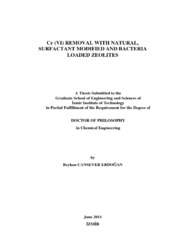Please use this identifier to cite or link to this item:
https://hdl.handle.net/11147/2888Full metadata record
| DC Field | Value | Language |
|---|---|---|
| dc.contributor.advisor | Ülkü, Ayşe Semra | - |
| dc.contributor.author | Cansever Erdoğan, Beyhan | - |
| dc.date.accessioned | 2014-07-22T13:48:33Z | |
| dc.date.available | 2014-07-22T13:48:33Z | |
| dc.date.issued | 2011 | - |
| dc.identifier.uri | http://hdl.handle.net/11147/2888 | - |
| dc.description | Thesis (Doctoral)--Izmir Institute of Technology, Chemical Engineering, Izmir, 2011 | en_US |
| dc.description | Includes bibliographical references (leaves: 246-262) | en_US |
| dc.description | Text in English; Abstract: Turkish and English | en_US |
| dc.description | xx, 317 leaves | en_US |
| dc.description.abstract | The objective of the study is to determine the bacteria removal performances of the local clinoptilolite rich mineral and its surfactant modified forms and to investigate potential applications of clinoptilolite rich mineral, surfactant modified clinoptilolite rich mineral and bacteria loaded forms in Cr (VI) sorption. Characterizations of clinoptilolite rich mineral and its modified forms were studied. Batch sorption experiments were performed and the effects of the parameters such as pH, initial concentration, agitation speed, particle size and temperature were investigated. Sorption kinetic data were analysed by external mass transfer, intraparticle diffusion, pseudo first and second order models. Intraparticle diffusion model results indicated that sorption of Cr (VI) on the sorbents was a multi-step process, involving external and intraparticle diffusion. Effective diffusion coefficient results implied that Cr (VI) sorption process was not solely intraparticle diffusion controlled and external film diffusion was also effective. Biot number (100-3000) results indicated that Cr (VI) sorption process was mainly controlled by intraparticle diffusion. The sorption reaction model results revealed that sorption of Cr (VI) onto sorbents was well represented by the pseudo-second order kinetic model. Sorption isotherm model results indicated that the Langmuir isotherm fitted well with the experimental data. Thermodynamic analysis, Gibbs energy change (<-20 kJ/mol), entropy change of sorption (<-0.2 kJ/mol K), enthalpy change (<-100kJ/mol) and activation energy (<40 kJ/mol) showed that sorption process was exothermic, spontaneous and physical sorption. | en_US |
| dc.language.iso | en | en_US |
| dc.publisher | Izmir Institute of Technology | en_US |
| dc.publisher | Izmir Institute of Technology | en_US |
| dc.rights | info:eu-repo/semantics/openAccess | en_US |
| dc.subject.lcsh | Zeolites | en |
| dc.subject.lcsh | Bacteria | en |
| dc.subject.lcsh | Chromium | en |
| dc.subject.lcsh | Clinoptilolite | en |
| dc.subject.lcsh | Zeolites--Absorption and adsorption | en |
| dc.title | Cr (vi) Removal With Natural, Surfactant Modified and Bacteria Loaded Zeolites | en_US |
| dc.type | Doctoral Thesis | en_US |
| dc.authorid | TR131392 | - |
| dc.institutionauthor | Cansever Erdoğan, Beyhan | - |
| dc.department | Thesis (Doctoral)--İzmir Institute of Technology, Chemical Engineering | en_US |
| dc.relation.publicationcategory | Tez | en_US |
| dc.identifier.wosquality | N/A | - |
| dc.identifier.scopusquality | N/A | - |
| item.openairecristype | http://purl.org/coar/resource_type/c_18cf | - |
| item.languageiso639-1 | en | - |
| item.openairetype | Doctoral Thesis | - |
| item.grantfulltext | open | - |
| item.fulltext | With Fulltext | - |
| item.cerifentitytype | Publications | - |
| Appears in Collections: | Phd Degree / Doktora | |
Files in This Item:
| File | Description | Size | Format | |
|---|---|---|---|---|
| T000899.pdf | DoctoralThesis | 4.92 MB | Adobe PDF |  View/Open |
CORE Recommender
Page view(s)
304
checked on Mar 31, 2025
Download(s)
210
checked on Mar 31, 2025
Google ScholarTM
Check
Items in GCRIS Repository are protected by copyright, with all rights reserved, unless otherwise indicated.